Showing Spotlights 1705 - 1712 of 2785 in category All (newest first):
 The recent oil spill in the Gulf of Mexico is widely acknowledged to be among the worst ocean oil spills in world history. Inevitably, the spill has once again raised serious concerns worldwide about the likely environmental impact of such catastrophic oil spills caused by oil tanker accidents at sea or mishaps during loading and unloading of oil from tankers at seaports. Numerous solutions have been proposed for dealing with the problem of oil spills. Conventional techniques are not adequate to solve the problem of massive oil spills. In recent years, nanotechnology has emerged as a potential source of novel solutions to many of the world's outstanding problems. Although the application of nanotechnology for oil spill cleanup is still in its nascent stage, there has been particularly growing interest in exploring ways of finding suitable solutions to clean up oil spills through use of nanomaterials.
The recent oil spill in the Gulf of Mexico is widely acknowledged to be among the worst ocean oil spills in world history. Inevitably, the spill has once again raised serious concerns worldwide about the likely environmental impact of such catastrophic oil spills caused by oil tanker accidents at sea or mishaps during loading and unloading of oil from tankers at seaports. Numerous solutions have been proposed for dealing with the problem of oil spills. Conventional techniques are not adequate to solve the problem of massive oil spills. In recent years, nanotechnology has emerged as a potential source of novel solutions to many of the world's outstanding problems. Although the application of nanotechnology for oil spill cleanup is still in its nascent stage, there has been particularly growing interest in exploring ways of finding suitable solutions to clean up oil spills through use of nanomaterials.
Feb 21st, 2011
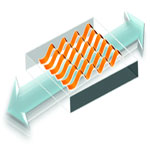 Previous research has shown that high performance piezoelectric ceramics PZT (lead zirconate titanate) could be printed as nanoribbons onto biocompatible and flexible substrates for applications such as harvesting energy from human motion like walking or breathing. While some motions, such as walking, only require flexibility, others, such as breathing, require that the materials be not just flexible but also stretchable. However, the PZT ribbons cannot stand stretching operation modes due to their brittle nature, which leads to cracking. The research team therefore has been looking to overcome this difficulty by fashioning the piezoelectric ribbons into wavy shapes, and integrating them with stretchable silicone rubber, such that the composite material can withstand large amounts of elastic strain.
Previous research has shown that high performance piezoelectric ceramics PZT (lead zirconate titanate) could be printed as nanoribbons onto biocompatible and flexible substrates for applications such as harvesting energy from human motion like walking or breathing. While some motions, such as walking, only require flexibility, others, such as breathing, require that the materials be not just flexible but also stretchable. However, the PZT ribbons cannot stand stretching operation modes due to their brittle nature, which leads to cracking. The research team therefore has been looking to overcome this difficulty by fashioning the piezoelectric ribbons into wavy shapes, and integrating them with stretchable silicone rubber, such that the composite material can withstand large amounts of elastic strain.
Feb 18th, 2011
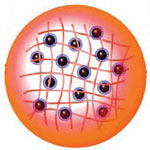 The particular physical properties that result from their unusual state of matter - they combine the properties of solids and fluids - make hydrogels ideal candidates for a number of applications. Nanoscale colloidally stable particles made from hydrogels are referred to as nanogels and these material systems have many general advantages, such as high transparency, high diffusion rates, high surface area, high dispersion stability, and monodispersity. Researchers in Japan have now proposed a novel photochemical application toward artificial photosynthesis using nanogels as nanogenerators, which evolve hydrogen gas from the internal water induced by irradiation with visible light. Actually, these nanogel systems generated hydrogen gas more efficiently than conventional solution systems.
The particular physical properties that result from their unusual state of matter - they combine the properties of solids and fluids - make hydrogels ideal candidates for a number of applications. Nanoscale colloidally stable particles made from hydrogels are referred to as nanogels and these material systems have many general advantages, such as high transparency, high diffusion rates, high surface area, high dispersion stability, and monodispersity. Researchers in Japan have now proposed a novel photochemical application toward artificial photosynthesis using nanogels as nanogenerators, which evolve hydrogen gas from the internal water induced by irradiation with visible light. Actually, these nanogel systems generated hydrogen gas more efficiently than conventional solution systems.
Feb 17th, 2011
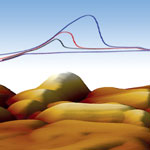 The copper Damascene electrodeposition is a key fabrication process, currently used in state-of-the-art, multilevel copper metallization of microelectronic interconnects that range from transistor to circuit board length scale. This strongly technology-driven application serves as a key motivator for applied and fundamental mechanistic studies that can spur further development and optimization of the copper electrodeposition process. This report effectively demonstrates the ability of the FlexAFM to monitor morphological changes during electrodeposition of material on an electrode surface. In the data shown here, copper was deposited on a flame annealed gold surface. The deposition process was shown to be fully reversible: At low potentials copper was deposited and at higher potentials it was dissolved again. Deposition and dissolution took place very rapidly, within one AFM scan line.
The copper Damascene electrodeposition is a key fabrication process, currently used in state-of-the-art, multilevel copper metallization of microelectronic interconnects that range from transistor to circuit board length scale. This strongly technology-driven application serves as a key motivator for applied and fundamental mechanistic studies that can spur further development and optimization of the copper electrodeposition process. This report effectively demonstrates the ability of the FlexAFM to monitor morphological changes during electrodeposition of material on an electrode surface. In the data shown here, copper was deposited on a flame annealed gold surface. The deposition process was shown to be fully reversible: At low potentials copper was deposited and at higher potentials it was dissolved again. Deposition and dissolution took place very rapidly, within one AFM scan line.
Feb 16th, 2011
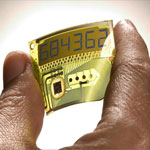 Printed electronics has its origins in conductive patterns printed as part of conventional electronics, forming flexible keyboards, antennas and so on. Then came fully printed testers on batteries, electronic skin patches and other devices made entirely by printing, including batteries and displays. A clear next step has been to modernise static print with the e-reader and the talking poster with animated, light emitting display and solar power. These are partly or almost wholly printed, with a clear roadmap to making them lower cost and more reliable and flexible by using printing more fully in their manufacture in future. However, we now see printed electronics and electrics certain to penetrate far more applications than anyone realised.
Printed electronics has its origins in conductive patterns printed as part of conventional electronics, forming flexible keyboards, antennas and so on. Then came fully printed testers on batteries, electronic skin patches and other devices made entirely by printing, including batteries and displays. A clear next step has been to modernise static print with the e-reader and the talking poster with animated, light emitting display and solar power. These are partly or almost wholly printed, with a clear roadmap to making them lower cost and more reliable and flexible by using printing more fully in their manufacture in future. However, we now see printed electronics and electrics certain to penetrate far more applications than anyone realised.
Feb 15th, 2011
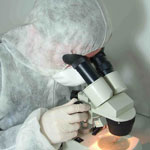 There is a need for the larger nanotechnology community synthesizing, applying or characterizing nanomaterials to have a methodology to evaluate the risk and to apply adequate protection measures to limit human exposure. Researchers in Switzerland have now taken the initiative and presented a practical, user-friendly procedure for a university-wide safety and health management of nanomaterials, developed as a multi-stakeholder effort (government, accident insurance, researchers and experts for occupational safety and health). The procedure consists of two parts: Using a decision tree, nano-labs are sorted into three hazard classes, which corresponds to analogue approaches applied to other hazard types (biohazard, radioprotection or chemistry). A list of required prevention/protection measures (safety barriers) for each hazard level is then provided.
There is a need for the larger nanotechnology community synthesizing, applying or characterizing nanomaterials to have a methodology to evaluate the risk and to apply adequate protection measures to limit human exposure. Researchers in Switzerland have now taken the initiative and presented a practical, user-friendly procedure for a university-wide safety and health management of nanomaterials, developed as a multi-stakeholder effort (government, accident insurance, researchers and experts for occupational safety and health). The procedure consists of two parts: Using a decision tree, nano-labs are sorted into three hazard classes, which corresponds to analogue approaches applied to other hazard types (biohazard, radioprotection or chemistry). A list of required prevention/protection measures (safety barriers) for each hazard level is then provided.
Feb 14th, 2011
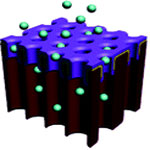 Controlled-release drug delivery techniques use various responsive materials and stimuli such as an implanted heat source or electronic chip to trigger the drug release from the implanted reservoir. Among many actively controlled stimuli for pulsatile drug delivery, the electrical signal would be the best source because it is portable and does not need large or special equipment to trigger it. The signal can also be easily and on-demand controllable, and long cycles are possible. Furthermore, when a sensor or microchip system is combined, the feedback and remote control outside the body is possible. Researchers have now developed a new drug delivery device for pulsatile and on-demand drug release based on electrically actuatable nanoporous membranes made of polypyrrole.
Controlled-release drug delivery techniques use various responsive materials and stimuli such as an implanted heat source or electronic chip to trigger the drug release from the implanted reservoir. Among many actively controlled stimuli for pulsatile drug delivery, the electrical signal would be the best source because it is portable and does not need large or special equipment to trigger it. The signal can also be easily and on-demand controllable, and long cycles are possible. Furthermore, when a sensor or microchip system is combined, the feedback and remote control outside the body is possible. Researchers have now developed a new drug delivery device for pulsatile and on-demand drug release based on electrically actuatable nanoporous membranes made of polypyrrole.
Feb 10th, 2011
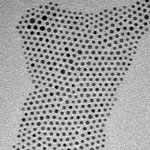 Their use in large-scale commercial applications requires cobalt nanoparticles with well-defined size and shape to be prepared in large quantities. Accurate tuning of the nanoparticle size and shape requires understanding of the mechanisms involved in particle nucleation and growth. In spite of extensive ongoing research, these mechanisms are still not fully understood owing to their complexity and interplay. Moreover, the current small-scale synthesis methods, such as the hot-injection method, can be difficult to scale to industrially relevant levels. In order to find more suitable methods for synthesizing cobalt nanoparticles, Finnish researchers revisited a widely studied hot-injection synthesis of monodisperse cobalt nanoparticles and show that the particle nucleation differs from what is expected for a hot-injection synthesis.
Their use in large-scale commercial applications requires cobalt nanoparticles with well-defined size and shape to be prepared in large quantities. Accurate tuning of the nanoparticle size and shape requires understanding of the mechanisms involved in particle nucleation and growth. In spite of extensive ongoing research, these mechanisms are still not fully understood owing to their complexity and interplay. Moreover, the current small-scale synthesis methods, such as the hot-injection method, can be difficult to scale to industrially relevant levels. In order to find more suitable methods for synthesizing cobalt nanoparticles, Finnish researchers revisited a widely studied hot-injection synthesis of monodisperse cobalt nanoparticles and show that the particle nucleation differs from what is expected for a hot-injection synthesis.
Feb 9th, 2011
 The recent oil spill in the Gulf of Mexico is widely acknowledged to be among the worst ocean oil spills in world history. Inevitably, the spill has once again raised serious concerns worldwide about the likely environmental impact of such catastrophic oil spills caused by oil tanker accidents at sea or mishaps during loading and unloading of oil from tankers at seaports. Numerous solutions have been proposed for dealing with the problem of oil spills. Conventional techniques are not adequate to solve the problem of massive oil spills. In recent years, nanotechnology has emerged as a potential source of novel solutions to many of the world's outstanding problems. Although the application of nanotechnology for oil spill cleanup is still in its nascent stage, there has been particularly growing interest in exploring ways of finding suitable solutions to clean up oil spills through use of nanomaterials.
The recent oil spill in the Gulf of Mexico is widely acknowledged to be among the worst ocean oil spills in world history. Inevitably, the spill has once again raised serious concerns worldwide about the likely environmental impact of such catastrophic oil spills caused by oil tanker accidents at sea or mishaps during loading and unloading of oil from tankers at seaports. Numerous solutions have been proposed for dealing with the problem of oil spills. Conventional techniques are not adequate to solve the problem of massive oil spills. In recent years, nanotechnology has emerged as a potential source of novel solutions to many of the world's outstanding problems. Although the application of nanotechnology for oil spill cleanup is still in its nascent stage, there has been particularly growing interest in exploring ways of finding suitable solutions to clean up oil spills through use of nanomaterials. 
 Subscribe to our Nanotechnology Spotlight feed
Subscribe to our Nanotechnology Spotlight feed





